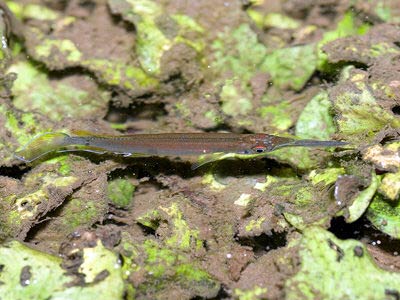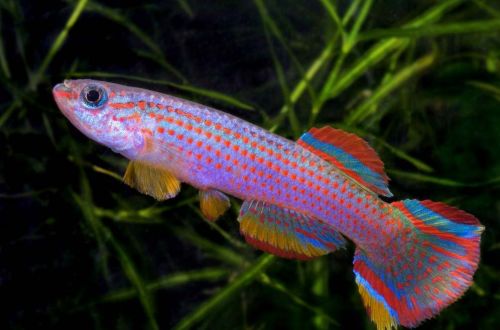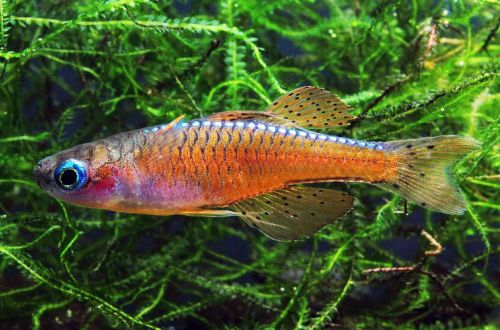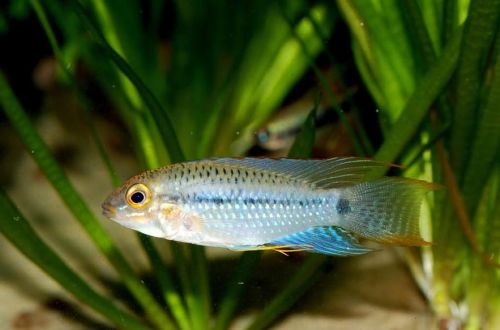
Apistogram of Steindachner
Steindachner’s Apistogramma, scientific name Apistogramma steindachneri, belongs to the Cichlidae family (cichlids). The fish is named after the Austrian zoologist Franz Steindachner. During its discovery in 1908, it changed its name three times as the genus Apistogram was studied. Features of behavior and a rather narrow range of optimal conditions make it moderately difficult to maintain. Recommended for experienced aquarists.

Contents
Habitat
It comes from South America from the territory of Guyana and Suriname. Inhabits the basins of the rivers Essequibo, Demerara, Corantein, Suriname – the river of the same name with the name of the state. The natural habitat is small rivers and streams flowing under the canopy of a tropical rainforest. The channels, as a rule, are littered with a layer of fallen leaves, under which snow-white sand is visible, the flow is blocked by fallen tree trunks, branches, and roots. The water is clean, but at the same time it is colored brownish due to the abundance of tannins formed as a result of the decomposition of plant organic matter.
Brief information:
- The volume of the aquarium – from 80 liters.
- Temperature – 20-25°C
- Value pH — 4.0–7.5
- Water hardness – 0–10 dGH
- Substrate type – sandy
- Lighting – subdued
- Brackish water – no
- Water movement is weak
- The size of the fish is 5–8 cm.
- Food – any food
- Temperament – conditionally peaceful, males are territorial during spawning
- Keeping in a group with one male and several females
Description
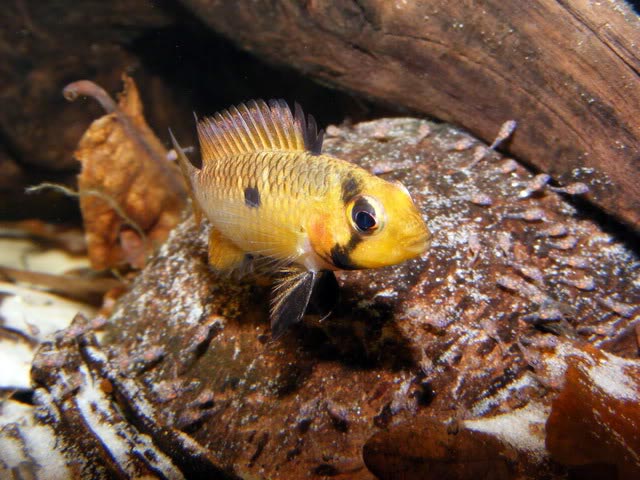
Adult males reach a length of about 8 cm. At a young age, the color is silver-blue, and a narrow black stripe runs along the body along the lateral line. As they grow older, blue shades almost completely disappear, remaining only on the anal fin. The body acquires gray colors with dark pigmentation.
Females are smaller in size – up to 5 cm. The color is yellow. The body pattern consists of a black spot in the middle of the body and a diagonal line running along the head of the fish.
Food
Omnivorous species, accepts most popular foods designed for aquarium fish. The daily diet can consist of both high-quality dry food in the form of flakes, granules, as well as in combination with live or frozen brine shrimp, daphnia, bloodworms.
Maintenance and care, arrangement of the aquarium
The optimal size of the aquarium for a group of 3-4 fish starts from 80 liters. The basis of the design is sandy soil and driftwood. If breeding is planned, then it is necessary to provide shelters that the fish will use as a spawning ground. The lighting is subdued. Aquatic plants are optional.
An additional element of decor can be dried tree leaves. Their presence will give the aquarium more naturalness, as well as give the water a brown tint, characteristic of natural reservoirs. Read more in the article “Which tree leaves can be used in an aquarium.”
The long-term maintenance of the Steindachner’s Apistogram is largely dependent on maintaining stable water conditions, which also have a rather narrow range of acceptable temperatures, pH and dGH values. The key to achieving this goal is the filtration system and regular maintenance of the aquarium. The latter include the weekly replacement of part of the water with fresh water, its periodic check for the presence of dangerous concentrations of nitrogen cycle products, the timely removal of organic waste (excrement, food residues), the replacement of tree leaves, if any, equipment maintenance, etc.
Behavior and Compatibility
Males are belligerent towards each other, which is especially evident during the spawning period. It is desirable to maintain the size of the Apistogram group in the ratio of one male to several females. If there is a large free space, the joint keeping of several males is permissible.
They are calm with other fish, compatible with non-aggressive species of comparable size.
Breeding / breeding
With the onset of the mating season, the male occupies a site at the bottom of the aquarium and begins to attract females. When they are ready, they accept the courtship of a partner and lay their eggs in cracks or voids among decorative elements, or in prepared shelters. The female stays near the clutch to protect her, the male usually returns to his territory and does not take part in caring for the offspring. Although, there are cases when he jointly helped protect the brood.
The incubation period lasts 36-72 hours depending on the temperature. After a few days, the fry begin to swim freely.
Fish diseases
The main cause of diseases lies in the conditions of detention, if they go beyond the permissible range, then immunity suppression inevitably occurs and the fish becomes susceptible to various infections that are inevitably present in the environment. If the first suspicions arise that the fish is sick, the first step is to check the water parameters and the presence of dangerous concentrations of nitrogen cycle products. Restoration of normal/suitable conditions often promotes healing. However, in some cases, medical treatment is indispensable. Read more about symptoms and treatments in the Aquarium Fish Diseases section.



